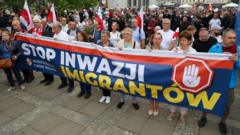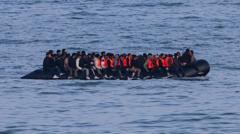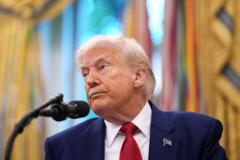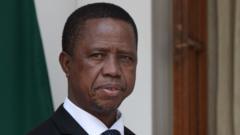Denmark's approach to immigration has shifted drastically, with the Social Democrats adopting hardline policies previously associated with the right. This transformation reflects wider political trends in Europe, where migration remains a key voter issue amidst growing social tensions.
Denmark's Shift: The Left Embraces Hardline Immigration Policies
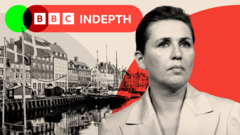
Denmark's Shift: The Left Embraces Hardline Immigration Policies
As migration becomes a pressing issue in Europe, Denmark's left-leaning government is pioneering hardline immigration strategies, challenging traditional liberal narratives.
Denmark is increasingly recognized as a pioneer of restrictive migration policies in Europe. According to Marie Sandberg, Director of the Centre for Advanced Migration Studies at the University of Copenhagen, the nation has set stringent limits on both asylum seekers and economic migrants. Unlike the expected rise of far-right politicians in response to migration fears, it is the center-left, led by Prime Minister Mette Frederiksen, that has spearheaded these initiatives.
The urgency surrounding migration has surged amid geopolitical tensions, including the war in Ukraine and concerns over cyberattacks. With migration emerging as a top voter priority, Denmark has significantly altered its narrative. Since the post-World War II era, the number of immigrants has dramatically increased, prompting local officials to express concerns over the strains on public services and community cohesion.
In 2015, during the migration crisis that brought over a million migrants to Europe, Denmark became widely scrutinized for its hardline measures, including confiscating valuables from asylum seekers to offset their accommodation costs. Laws have only intensified since then, with the government now advocating for processing asylum claims outside Europe. Past proposals included the controversial idea of detaining migrants on an island.
Frederiksen's Social Democrats, in a move that some describe as an ideological shift toward the right, have implemented policies reminiscent of the far-right Danish People's Party. This pivot involves balancing immigration control with fostering strong public services, a cornerstone of Denmark's high-tax welfare model. Critics, however, accuse the government of exploiting migration fears for political gain.
International responses have been mixed. While Denmark's immigration applications have significantly dropped, concerns have risen regarding the degradation of the country's humanitarian reputation. Critics point to legislation perceived as increasingly discriminatory, as the state's policies render many migrants feeling more like outsiders.
In contrast, Spain's center-left government under Prime Minister Pedro Sanchez advocates for a more inclusive approach, seeking to regularize nearly one million undocumented migrants to bolster its economy. With demographic changes and labor shortages, Sánchez emphasizes responsible migration management, initiating dialogues with NGOs to innovate policies.
Across Europe, political lines are blurring, with parties from both the left and right adopting rhetoric and policies traditionally seen as oppositional. As each nation navigates its unique challenges, the quest for an ideal immigration policy that balances humanitarian values and economic necessities persists, with public sentiment often favoring a compromise that addresses both concerns and needs. The evolution of immigration policy in Denmark exemplifies broader European trends and the complexities of governance in uncertain times.
The urgency surrounding migration has surged amid geopolitical tensions, including the war in Ukraine and concerns over cyberattacks. With migration emerging as a top voter priority, Denmark has significantly altered its narrative. Since the post-World War II era, the number of immigrants has dramatically increased, prompting local officials to express concerns over the strains on public services and community cohesion.
In 2015, during the migration crisis that brought over a million migrants to Europe, Denmark became widely scrutinized for its hardline measures, including confiscating valuables from asylum seekers to offset their accommodation costs. Laws have only intensified since then, with the government now advocating for processing asylum claims outside Europe. Past proposals included the controversial idea of detaining migrants on an island.
Frederiksen's Social Democrats, in a move that some describe as an ideological shift toward the right, have implemented policies reminiscent of the far-right Danish People's Party. This pivot involves balancing immigration control with fostering strong public services, a cornerstone of Denmark's high-tax welfare model. Critics, however, accuse the government of exploiting migration fears for political gain.
International responses have been mixed. While Denmark's immigration applications have significantly dropped, concerns have risen regarding the degradation of the country's humanitarian reputation. Critics point to legislation perceived as increasingly discriminatory, as the state's policies render many migrants feeling more like outsiders.
In contrast, Spain's center-left government under Prime Minister Pedro Sanchez advocates for a more inclusive approach, seeking to regularize nearly one million undocumented migrants to bolster its economy. With demographic changes and labor shortages, Sánchez emphasizes responsible migration management, initiating dialogues with NGOs to innovate policies.
Across Europe, political lines are blurring, with parties from both the left and right adopting rhetoric and policies traditionally seen as oppositional. As each nation navigates its unique challenges, the quest for an ideal immigration policy that balances humanitarian values and economic necessities persists, with public sentiment often favoring a compromise that addresses both concerns and needs. The evolution of immigration policy in Denmark exemplifies broader European trends and the complexities of governance in uncertain times.



